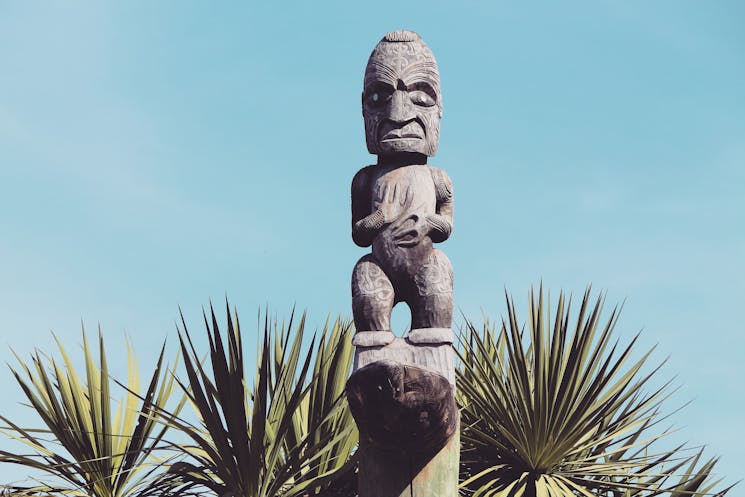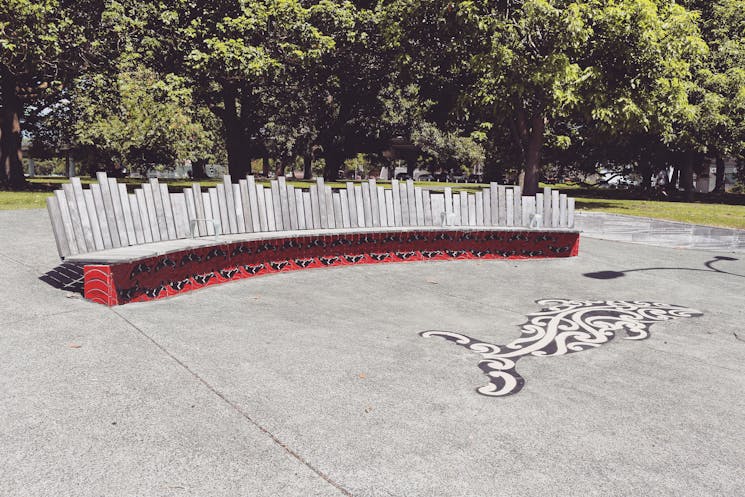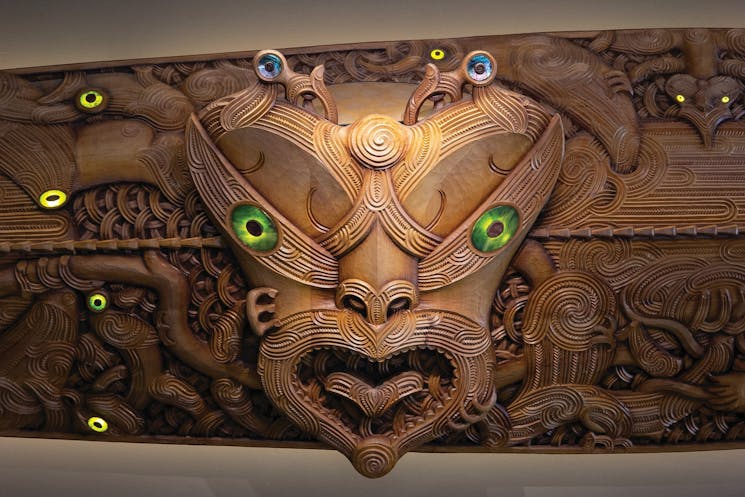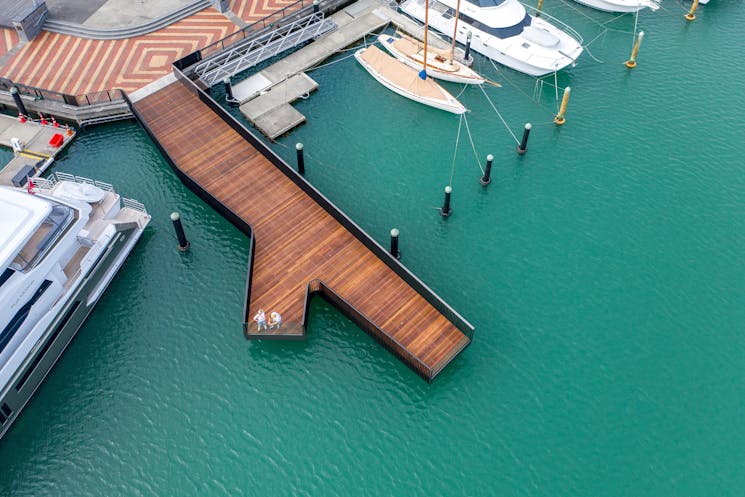
Reihana and Nicholas (Kupenga Design) were commissioned to tell the stories of the area in their design. The footbridge represents a draped fishing net, recognising the bay’s significance as an important fishing area in the past. Its prismatic form was created to reflect the light and colours of the surrounding landscape.
The whakataukī (proverb) set in concrete at the top of the walkway from the city side, reads: ‘Tāmaki Makaurau kainga ngā ika me ngā wheua katoa – Tāmaki, where the fish are so succulent you can eat them, bones and all!’

Two pou whenua (landmark posts) were carved for this skateboard and BMX course to enhance the visual appeal of the skate park and to reflect Ngāti Whātua’s historical associations with the area.
The pou pictured, named Te Mau Mahara, was carved by Ralph, who is a legendary skateboarder. It shows a figure with its arms tightly embracing a skateboard recognising what the park is used for.
The second pou, carved by Phillips, named Waiatarau (reflecting waters) references the stream that ran through the site and its significance as a source of kai (food).

This seat recognises the Ngāti Pāoa tribe, with themes of mahinga kai (food gathering). They occupied land on both sides of the isthmus with pā (fortified villages) at Te Tō (Freemans Bay), Mokoia, Mauinaina (Panmure) and Takapuna (North Head).
‘Ehara taku toa i te toa takitahi, engari he toa takitini’ series, 2005
Graham Tīpene (Ngāti Whātua Ōrākei),
Thomas Barter, ceramic artist
The title is an inspirational whakataukī (proverb) - ‘by one who pays tribute to the contributions of many for a job well done, rather than taking kudos for oneself.’ The mosaic references the use of the area by Māori.

The artists guided the structure’s architecture which is in the form of a hīnaki (eel trap). Its circular arrangement, inner entry tube and netting design all replicate the forms of sticks, flax netting and cordage elements used in the traditional Māori traps.
Symbols for water and whakataukī (proverbs) relating to water complement the play structure. Stories about the harvest and maramataka (lunar cycle) are used in the carved timber pou (posts) which feature pāua (abalone) shell inlay.

Tīramarama means to glimmer and light the way. Mātauranga Māori (traditional knowledge) and kaitiakitanga (guardianship) values are embedded in the lane’s unique design. Stars specific to Māori astronomy, Te Puanga (Rigel in Orion) and Matariki (Pleiades) are expressed in the lighting.
Te Puanga heralds the start of winter. It is said to be one of the parents of puawānanga (native plant/Clematis) which has been planted next to the lane and flowers in spring. When Te Puanga and Matariki light the way, it is time to wānanga (gather and learn), whanaungatanga (be with others) to restore faith and hope for the future, share kai (food) and celebrate.

- Papatūānuku* reflects the ever-changing colours and patterns of the seasons within our terrestrial and celestial realms, influenced by the maramataka (Māori lunar calendar).
The glass poi (balls attached to strings used in dance) colours represent key messengers, including the local whai (stingray) which are often seen gliding through the waters nearby.
The vibrant wall colour reflects Tama-nui-te-rā (the sun) and Te Ahikāroa, Mei’s Ōrākei whānau (family) who keep the homes fires burning here in Te Pokapū o Tāmaki – Central Auckland. An urban surprise and celebration of nature and culture.

This title of this wall of giant-size, stacked Cuisenaire-like rods title speaks to the heartfelt loss of te reo (the Māori language) and the hope for language regeneration.
The use of Cuisenaire Rods is an homage to the Māori language revitalisation movement and the Te Ataarangi teaching style. Te Ataarangi used the rods as a learning tool. Established 45 years ago, it has supported more than 100,000 people to speak Te Reo Māori (the Māori language).
Cuisenaire Rods were developed in the 1950s for maths education. The work’s title is also a nod to Piet Mondrian’s 1942/43 painting Broadway Boogie Woogie, and to the 1990s pop song.

This 6.4-metre carved wooden pou (post) commemorates Māui (a demi- god). Māui features heavily in Māori narratives and this work represents three key stories involving him. The three figures crowning the pou represent Māui slowing the sun, Māui fishing up the North Island and Māui acquiring fire from Mahuika, the goddess of fire.
The sculpture serves as a focal point for pōhiri (ceremonial welcomes) and other official events held at the theatre.
Jahnke’s works often weave in political messages that highlight important issues for the Māori people.

Te Nukuao was inspired by weaving patterns found in the sole remaining customary Māori sail, Te Rā. Harris’s mahi (work) explores the narrative, form, and symbolic presence of waka hourua (double hulled canoe sails) as a reference to the history of Wynyard Quarter as a 'water space' prior to and reclamation. The sail-inspired shade serves as a cultural marker for mana whenua (indigenous people) and offers shelter. The ingoa (name) Te Nukuao (shelter) was gifted by Zaelene Maxwell-Butler,

The name of this carving is drawn from a local whakataukī (proverb) which describes Tāmaki Makaurau (Auckland) as the resting place of many waka (canoes) and is a reference to the layers of tribal associations with Tāmaki Makaurau. It expresses that Auckland is a safe haven for all people to commune as one.
The direct translation is ‘safe place to park your boat’. The carving in waka (canoe) form reflects the themes of safe arrival, whakawhanaungatanga (welcome and hospitality) and the weaving of culture to enable human connections.

This giant scale, 11-metre wide, work uses distinctive geometric Māori patterns that have been woven, painted and illuminated with LEDs to symbolize protection, strength and the pathway to the sea.
It is made of several layers of acrylic gauze painted on both sides with the gauze pushed through the layers, similar to traditional Māori tukutuku weaving.
Tukutuku is a decorative woven latticework, usually of flax woven in the form of panels that are usually between the carved pou (posts) of communal buildings such as a wharenui (meeting house).

Tipene was engaged to join LandLAB on the creative journey which saw this structure evolve from a simple wharf extension into a dramatic sculptural form, representing a taurapa (the stern of a waka) lying on its side.
This sculptural pier-like installation extends 30 meters out from Waitematā Plaza promenade into the Viaduct Harbour water space. Commissioned privately by Viaduct Harbour Holdings, the structure is designed to enhance the public’s connection to the water itself, with its name, Te Mata Topaki (to hover over the headland), a clue to the experience it sets out to create.

The Viaduct Harbour was redeveloped for the America’s Cup in 2000. Elements and symbols with cultural significance to Ngāti Whātua Ōrākei, the tangata whenua (local indigenous people) were included in the design, ensuring the environment reflected their presence, status and stories.
The use of the pātiki (flounder) pattern can be seen in the paving design symbolic of this local delicacy and the values of manaakitanga (hospitality). A flounder is a diamond shaped flat fish that was an important food source for early iwi (tribes). The diamond patterning symbolises plentiful times and progression in a forward movement, as the pātiki travels in a forward direction only.
